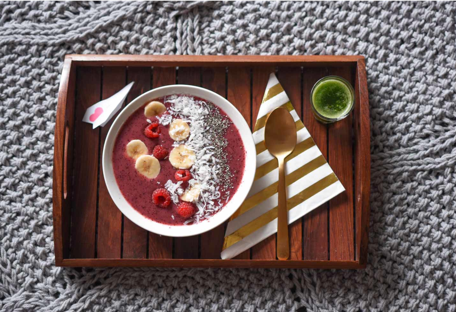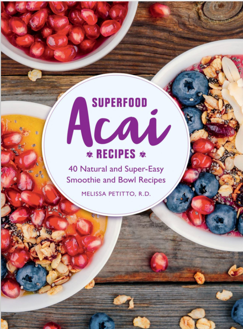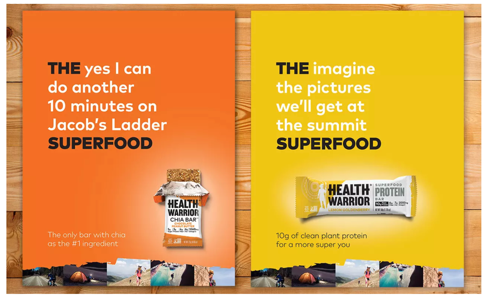The Murky Marketing of Superfoods—The Case of Açaí
This week we are featuring work from students in Val Ryan’s class The Science of Food and Cooking (MET ML619). Today’s post comes from Gastronomy student Mara Sassoon.
Açaí: by now, the purple Brazilian berry is ubiquitous in the United States. Most often, it is found in the form of a frozen pulp that is mixed with bananas or other berries into vibrant frozen smoothie bowls, a dish that has become increasingly popular over the past few years, popping up in restaurants and cafés and on Instagram feeds (fig. 1). Recently, even Trader Joe’s and Dole have gotten in on the trend, offering premade versions one can find in the frozen food aisle of the grocery store. But why has the purple treat become so popular?

Jamie Lauren Keiles gets to the main reason for the açaí craze in her 2017 article for the New York Times Magazine titled, “The Superfood Goldrush.” She interviewed the owner of a so-called “superfood café” in Los Angeles about the smoothie bowl’s appeal. His response? “The blend is like an ice cream. But healthy” (Keiles 2017, 34). Açaí, as Keiles’ article points out, has long been hyped as a health-packed ‘superfood,’ espoused for a multitude of potential benefits— marketers like to point out that is rife with antioxidants, and some even point to anti-aging and weight loss benefits from the berry.
Food and nutrition science have become entangled in the problematic strategies marketers use to claim positive health effects of so-called ‘superfoods.’ Examining how açaí or any of the many other ‘superfoods’ out there—among them, blueberries, pomegranate, kale, and quinoa—have been advertised over the last fifteen to twenty years reveals how food and nutrition science are negatively utilized by marketers to influence how people perceive nutrition and healthy eating.
“Every food producer wants to expand sales. Health claims sell. The FDA requires research to support health claims and greatly prefers studies that involve human subjects rather than animals,” Marion Nestle writes in a 2018 article for The Atlantic, “Superfoods are a Marketing Ploy” (Nestle 2018). In the article, Nestle details how food producers fund research to support health claims they make about their food, a perfect example of how food and nutrition science is shoehorned into supporting marketing goals. She specifically points out two producers, Royal Hawaiian Macadamia Nut and Wild Blueberries of North America. The claims their research produced? One: eating macadamia nuts every day could reduce the risk of heart disease and two: Wild Bluberries’ particular frozen blueberries are healthier than fresh blueberries.
As Nestle argues, the research funded by these industries is often misleading, organized around profit rather than around real concern for people’s healthy eating habits. This kind of research and these kinds of claims cast individual foods as cure-alls no matter what comprises the rest of a person’s diet. “To ask whether one single food has special health benefits defies common sense. We do not eat just one food,” Nestle writes. “But when marketing imperatives are at work, sellers want research to claim that their products are ‘superfoods,’ a nutritionally meaningless term.” Nestle would likely agree that the next time one digs a spoon into a frosty açaí bowl, one should think about the studies behind its health claims and who has funded them.
Indeed, açaí is not immune to such sensationalized health assertions. The use of the term ‘superfood’ is rampant when it comes to the fruit. Sambazon, one of the most popular companies for açaí products, labels it as “The Amazon Superfood” on its website (Sambazon, n.d.). The term is also present in relatively new recipe books: Melissa Petitto, a registered dietician, published the 2019 book Superfood Acai Recipes: 40 Natural and Super-Easy Smoothie and Bowl Recipes (fig. 2). At the beginning of the book, she cites the same supposed health benefits of the fruit that are widely promoted elsewhere—among them, positive effects on brain function, high levels of antioxidants and nutrients, and anticancer properties (Petitto 2019, 6). Many restaurants use the catchphrase, too: similar to the café Keiles describes in her article, Vitality Bowls, a popular franchised eatery with locations around the United States, specializes in açaí bowls and also dubs itself a “superfood café.”

In their paper, “Unlocking the Energy of the Amazon? The Need for a Food Fraud Policy Approach to the Regulation of Anti-Ageing Health Claims on Superfood Labelling,” Janine Curll, Christine Parker, Casimir MacGregor, and Alan Petersen delve into the problematic marketing of açaí as a ‘superfood.’ They include statistics to illustrate the sales impact of labeling something a ‘superfood,’ including that “blueberry sales reportedly doubled between 2005 and 2007” because of it (Curll et al. 2016, 420). However, Curll et al. argue that calling something a ‘superfood’ is tantamount to “food fraud,” referring to the misleading labeling or packaging of food. The authors, who are all from Australia, specifically examined açaí products available there, including powders, frozen pulp, pills, and drinks.
One common thread they observed was that many of the products included an “exotic back story” as part of a marketing tactic to make the products’ health claims seem more believable. They write, “Labelling implies that it is the mystical origins in the Amazon jungle itself that contributes to the superior properties of the açaí berry” (2016, 435). While not one of the brands they observed, Sambazon uses the same kind of tactic in its marketing, even working a positive environmental bent into its narrative: “Ancient legend tells us the entire Amazon was born of a single seed of Açaí. A gift from Princess Iaçã (her name spells Açaí backwards), its legendary powers are said to have saved its people from starvation while creating abundance for all who lived there. Today Açaí continues to protect the people of the Amazon, by making the forest more valuable standing than cut down” (Sambazon, n.d.).
Reflecting on Sambazon’s mythical story, however, one must question the impact the ‘superfood’ marketing and subsequent rise in sales of açaí have had on the environment. Extensive detrimental ecological impact due to increased açaí production has not been widely reported, however in a 2015 paper titled “Floristic impoverishment of Amazonian floodplain forests managed for açaí fruit production,” Madson Antonio Benjamin Freitas et al. report on a study they conducted on the impact of heightened demand for the fruit on the forests where it is grown. “Our study is the first to demonstrate a significant loss of local tree species richness and a trend toward floral impoverishment in Amazonian floodplain forests under intense açaí production,” they write, noting a negative impact on the variety of surrounding plant and tree species that they believe should be curtailed through conservation initiatives (Freitas et al. 2015, 24).
Curll et al. also observed that almost all of the products they examined touted anti-aging properties due to the levels of antioxidants found in the fruit (2016, 433). In fact, the rich antioxidant level of açaí is one of its most prevalently advertised benefits. Curll et al. point to açaí’s popularity as starting with a 2005 book by dermatologist Dr. Nicholas Perricone—and a subsequent publicity appearance on The Oprah Winfrey Show—in which he discussed the anti-aging benefits of the berry. In said book, The Perricone Promise: Look Younger, Live Longer in Three Easy Steps, he discusses the high level of antioxidants in the fruit and also praises its anthocyanins, pigments containing antioxidants, calling açaí berries “the richest anthocyanin sources by far” (Perricone 2005, 50).
Perricone and others have placed açaí on a pedestal that Curll et al. find problematic. They argue that, while the berries certainly possess many healthful qualities, they are perhaps no more healthy than other foods, writing, “‘superfood’ claims…seek to distinguish some fruit and vegetables, such as açai, from other ‘normal’, unbranded fruit and vegetables on the basis that a particular set of bioactive molecules (or ‘phytochemicals’) in the food are especially potent antioxidants” (2016, 433). Yet, other fruits contain comparable levels of phytochemicals to açaí. Bioactives in Fruit: Health Benefits and Functional Foods, edited by Margot Skinner and Denise Hunter, a more than 500-page tome detailing the nutrient compositions of various fruits, actually groups açaí with grapes, blackcurrants, strawberries, peaches, apples, blueberries, pomegranates, and others in its discussions of fruits with high levels of phytochemicals (Skinner and Hunter 2013, 468). This is yet another example of the potential for food and nutrition science to be used deceptively for marketing initiatives.
Other studies have found that açaí’s antioxidants have not been proven to be fully absorbed by the body. In The A-Z Guide to Food as Medicine, Diane Kraft and Ara DerMarderosian write that recent studies of the açaí berry—the first entry in the book—which is also often consumed as juice, found “‘no consistent clinical evidence of antioxidant potency’ of acai compared to other beverages, such as red wine” and that drinking the fruit’s juice and pulp “raised plasma antioxidant capacity but did not affect other markers of antioxidant activity such as antioxidant capacity of urine” (Kraft and DerMarderosian 2016, 1). These studies noted by Kraft and DerMarderosian show that food and nutrition science can also be used to fact-check health claims made by food companies, ironically, based on food science itself.
Look outside the realm of açaí products, and one can see that the term ‘superfood’ is widespread in food marketing (fig. 3). As Nestle points out in her article for The Atlantic, it is necessary to be an engaged and aware consumer who attempts to discern who conducted the studies that back up health claims and whether there could be any biases present. I realize that food scientists, researchers, nutritionists, and food companies must often work hand in hand due to the FDA’s requirement of research to back up health claims. Still, perhaps there could be more regulatory processes to avoid instances of studies seemingly designed to back up such claims specifically.

As many of the aforementioned scholars have pointed out, ‘superfood’ is a problematic term and, though unrealistic, it would be helpful to stop using the term entirely. It is still used irresponsibly by influential sources. For instance, Harvard is sending out mixed messaging on the term. The Harvard T.H. Chan School of Public Health published an article titled “Superfoods or Superhype?” which supports the notion that the term is problematic (Harvard T.H. Chan School of Public Health, n.d.). Yet, Harvard Health Publishing ran a blog post in 2018 titled “10 superfoods to boost a healthy diet” (McManus 2018). Doctor Mehmet Oz, regarded as a prominent authority on health topics, uses the term in his book, Food Can Fix It: The Superfood Switch to Fight Fat, Defy Aging, and Eat Your Way Healthy. Although he discusses in the introduction how people use the term problematically and that “no such food exists” (Oz 2017, 2), he is nonetheless using it in the title of his book because it is a catchy and enticing phrase. The term connotes a cure-all food, and as the example of açaí shows, that is an impossible feat.
Works Cited
Curll, Janine, Christine Parker, Casimir MacGregor, and Alan Petersen. 2016. “Unlocking the Energy of the Amazon? The Need for a Food Fraud Policy Approach to the Regulation of Anti-Ageing Health Claims on Superfood Labelling.” Federal Law Review 44, no. 3 (September): 419-449.
Freitas, Madson Antonio Benjamin, Ima Célia Guimarães Vieira, Ana Luisa Kerti Mangabeira Albernaz, José Leonardo Lima Magalhães, and Alexander Charles Lees. 2015. “Floristic impoverishment of Amazonian floodplain forests managed for açaí fruit production.” Forest Ecology and Management 351, no. 1 (September): 20-27.
Harvard T.H. Chan School of Public Health. n.d. “Superfoods or Superhype?” Accessed March 22, 2020. https://www.hsph.harvard.edu/nutritionsource/superfoods/.
Keiles, Jamie Lauren. 2017. “The Superfood Goldrush.” New York Times, May 2, 2017. https://www.nytimes.com/2017/05/02/magazine/the-superfood-gold- rush.html.
Kraft, Diane and Ara DerMarderosian. 2016. The A-Z Guide to Food as Medicine. New York: Taylor & Francis.
McManus, Katherine D. 2018. “10 superfoods to boost a healthy diet.” Accessed March 22, 2020. https://www.health.harvard.edu/blog/10-superfoods-to-boost-a-healthy-diet- 2018082914463.
Nestle, Marion. 2018. “Superfoods are a Marketing Ploy.” The Atlantic, October 23, 2018. https://www.theatlantic.com/health/archive/2018/10/superfoods-marketing- ploy/573583/.
Oz, Mehmet. 2017. Food Can Fix It: The Superfood Switch to Fight Fat, Defy Aging, and Eat Your Way Healthy. New York: Scribner.
Perricone, Nicholas. 2005. The Perricone Promise: Look Younger, Live Longer in Three Easy Steps. New York: Grand Central Publishing.
Petitto, Melissa. 2019. Superfood Acai Recipes: 40 Natural and Super-Easy Smoothie and Bowl Recipes. New York: Crestline.
Sambazon. n.d. “Discover the Benefits of Açaí.” Accessed March 22, 2020. https://www.sambazon.com/discover-acai.
Skinner, Margot and Denise Hunter, eds. 2013 Bioactives in Fruit: Health Benefits and Functional Foods. West Sussex: Wiley-Blackwell.
Images:
Fig. 1. Açaí smoothie bowl by Shari’s Berries. Available from: Flickr Commons, https://www.flickr.com/photos/sharisberries/33343287432/in/photolist-2ahDtTk-LwFo8K- NahEqS-N8pgB2-2ggEzkR-SNr4G5-MDgGLq-wHYMw-7Wb68R-2ggESpV-2ggEouW/ (accessed March 22, 2020).
Fig. 2. Cover of Superfood Acai Recipes: 40 Natural and Super-Easy Smoothie and Bowl Recipes by Melissa Petitto. Available from: Google Books, www.books.google.com/books/about/Superfood_Acai_Recipes.html?id=Pu2ODwAAQBAJ (accessed March 22, 2020).
Fig. 3. Advertising campaign for Health Warrior bars by Elevation Advertising. Available from: Elevation Advertising, http://www.elevationadvertising.com/brand-platform-superfood/ (accessed March 22, 2020